Reel Meets Realism
Shining the Light on Artist Patricia Chidlaw
By Roger Durling | Photos by Ingrid Bostrom | February 2, 2023

Read all of the stories in our “Locals-Only Sneak Peek at SBIFF” cover here.
Known for her masterful ability to capture both urban environments and changes in light, renowned artist Patricia Chidlaw was an inspired choice to create the 2023 Santa Barbara International Film Festival poster, a stunning depiction of the iconic Arlington Theatre. Here SBIFF Executive Director and a Santa Barbara Independent Contributing Writer Roger Durling shares his feature story about the painter — and the woman — behind the poster.
“Crop the bottom!” said the comment on Instagram about Patricia Chidlaw’s painting for the 38th Santa Barbara International Film Festival poster. It was a reaction that we expected. But it is the bottom half of the piece (which showcases a parking lot with cars stationed against a wall) that elevates the work to the sublime.
“To be sure, Patricia’s work beautifully captures environments while not editing out the visual noise of power lines, graffiti, and disrepair,” says David B. Walker, CEO of the Nevada Museum of Art, where Chidlaw had a major exhibit in 2014. “These elements play antagonist roles in her eloquent compositions.”
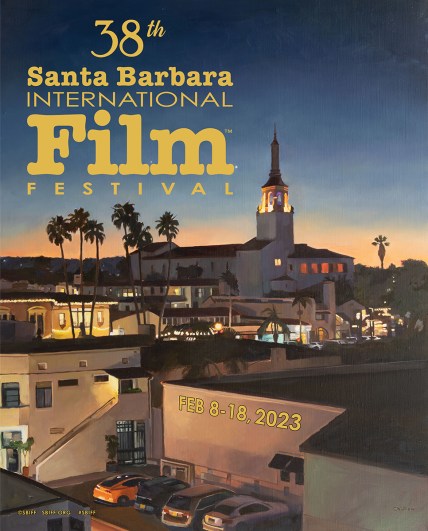
At the top of Chidlaw’s depiction for the poster is an exquisite Santa Barbara sky at dusk, and the Arlington Theatre is perched in all its grandeur. The viewpoint is one you’ve probably never seen before, and it makes you reevaluate the iconic building.
“I like to use contrasts to create drama in my paintings,” Chidlaw tells me. “I use contrasts of light and shadow, organic forms of nature opposed by the geometry of the built environment. I have been asked how I make neon look so bright, and the answer is that I make everything else really dark.”
Chidlaw — without a doubt one of this city’s greatest artists, has been painting for 40 years, developing an iconic style that is completely her own and instantly recognizable — the expression of a strong singular vision. The artist calls her works “urban landscapes,” and in them she depicts scenes that seem ordinary at first glance: the Greyhound bus station, the façade of Jimmy’s Oriental Gardens, the Paradise Café, a deserted Santa Barbara Street, or an abandoned alleyway. But it is the angle in which they’re presented, with the colors and geometric compositions both classical and abstract, that creates a sense of storytelling and drama that makes the work electric. Although she rarely features people in her paintings, there’s a feeling that these places have just been vacated or are about to be occupied. There’s an undercurrent of simultaneous feelings of deflation and hope — open to interpreting whether things may have just ended or they are about to begin. This creates a sense of anticipation and involvement for the viewer — she draws you in; you’re trying to figure out what just happened or will take place. Her scenes are not of new things, of new buildings, or new neighborhoods, but instead they’re imbued with history.

“I interpret her practice as capturing a moment in time,” says Walker. “We see the past, the present, and our imaginations are left to contemplate the future of these vignettes. Patricia’s paintings are narratives, and often read like Hollywood sets. Akin to the work of Edward Hopper, people are rarely present or at best a memory.”
My own modest art collection at home proudly includes two works by Chidlaw. I consider her and her realist-oriented paintings to be synonymous with Santa Barbara culture. Though our paths have crossed many times in the past 20 years, I hadn’t had a substantial conversation with her until writing this story, where we met three times during the 2022 winter holidays at her house in the downtown area.
She greets me by the white picket fence in front of her Craftsman house, which was built in 1912. Her husband, Bob Sponsel, bought it in 1980, and they were both excited to have a home to restore together after their marriage in 1982. They didn’t know much about Craftsman houses and started to learn everything about them. A ‘60s remodel had modernized the house, taken out the original wainscoting, and hidden the box beams on the ceiling.
Once you step inside, you feel you’ve traveled back to another era. A vintage clock marks time. The furnishings are all vintage. “The furniture is from Bob’s grandparents,” says Chidlaw. “We loved our grandparents’ homes. They were stable. Nothing ever changed.” The bathroom features a bathtub they found outside an old Victorian home that was being gutted. “We brought it here in a dolly,” she giddily says.
Chidlaw and Sponsel actually own two homes. Sponsel is a big-time collector of everything from classic cars to toy trains, and they’ve filled up this house as well as the second house. “We basically have too much stuff,” Chidlaw admits.
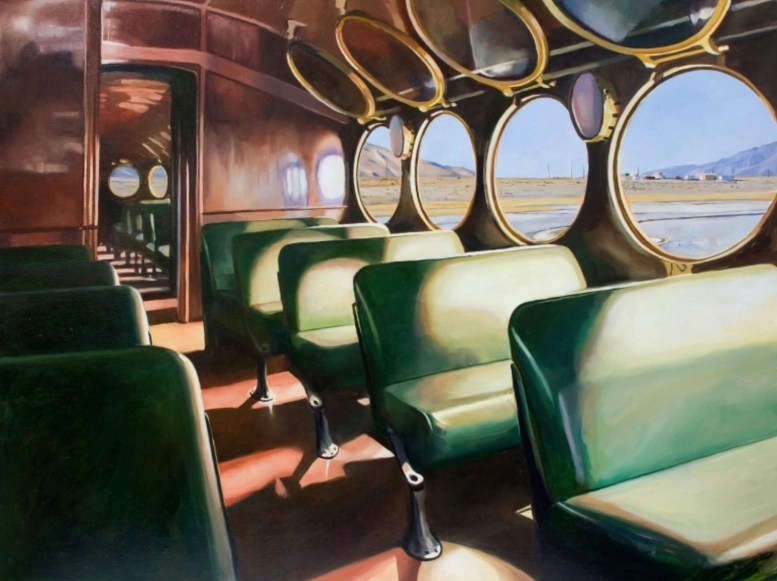
We sit down to talk in the back of the Craftsman house, in the enclosed porch that is her studio. Big windows provide natural light. Chidlaw is working on paintings for a show opening February 25 in Los Angeles at the Billis Williams Gallery. Ten canvases in different degrees of progression surround us. They’re a combination of drawings with washes of color. Chidlaw explains that she photographs specific areas and then returns to her studio to sketch a composition in red lines and then paint.
She then brings out the three paintings she did of the Arlington Theatre, which are currently on exhibit at Sullivan Goss Gallery. “On a conceptual level, I think movie theaters represent a fabulous version of what I do: a showcase for spectacularly big pictures,” she says. “Deco Art theaters were very beautiful and have provided me with many opportunities to paint neon, which I love. And the theaters that are no longer in use, abandoned and decaying palaces, provide the melancholic pleasure of grand ruins — haunted by all the stories that have played out in them. It is easy to imagine them as portals to another time.”
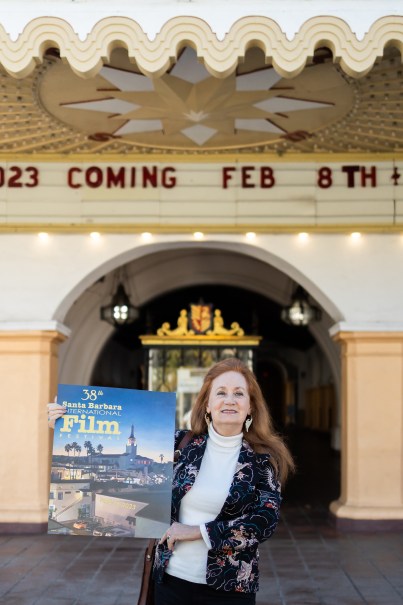
She remembers painting Santa Barbara’s Arlington Theatre for the first time in 1979, when there was a Union 76 gas station in front of it. Her finished work was shown by the S.B. Art Association at the Faulkner Gallery in the Central Library. She got a prize for it.
“When I was just starting out, I lived on De la Vina Street. I could see the Arlington tower, and it had the letters ‘FOX’ in lights with the ‘O’ burnt out,” she says.
Chidlaw’s mom, Josephine, originally from British Columbia, was an Army nurse. She was stationed in Europe during the war and eventually met her future husband, Richard, in occupied Japan, though he was from Santa Monica, California. After they married, Josephine resigned from the Army, and Richard remained and was stationed with NATO in Europe for a while. Chidlaw recalls spending her junior high years in Paris, part of her high school years in Italy, and her senior year in the Netherlands. “I got to see a lot of museums and spent a lot of years with almost no friends,” she says. “Seeing European painting growing up influenced how I look at the world.”
She took art classes in high school in painting and sculpture. “I was messing around,” she says. “It wasn’t serious. But I sold a lot of paintings when I was a teenager.”
She eventually decided to be an art major in college. People told her Santa Barbara was lovely, and she made up her mind to go to UCSB in 1969. “We weren’t judged on our portfolio to get in,” she remembers. “I didn’t know anything about how to paint. Traditional painting was out of fashion. Minimalism and conceptualism were the hot trends.”
Frustrated with what she was being taught, she took her easel out to paint at the lagoon one day — plein air style — and she was told she was painting like an old lady. “Irma Cavat was the only teacher who took a liking to me,” says Chidlaw. “She started her class with still lifes. I couldn’t make things up from scratch. I couldn’t pull the extraordinary out of nothing. I needed to start from something.
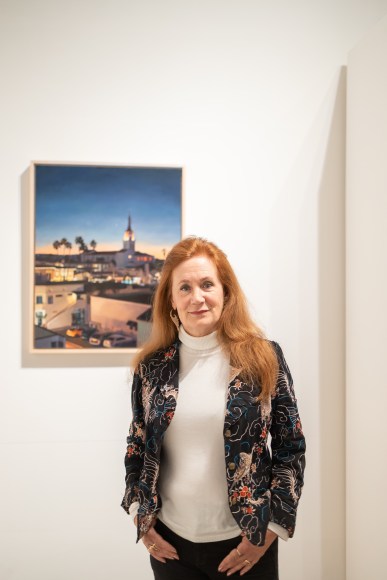
“The Bay Area figurative painters were a big influence during this period. Among the few people who were working with imagery, they were starting to be popular.” She names the early photorealist Robert Bechtle as an influence, as well as John Register, another realistic artist whom she wanted to paint like, and her favorite painter of all time, Richard Estes.
After graduating from UCSB, Chidlaw took adult ed courses and went to SBCC, where she met her future husband, Bob Sponsel, at a figure drawing class. She also got acquainted with some of the folks from the Oak Group, who had started a renaissance of plein air painting in California. They encouraged her to paint outdoors, and “it was useful to get me out painting,” she concedes, “although I didn’t stay long with the Oak Group.”
She stayed living in Santa Barbara by default. “I don’t remember consciously considering sticking around,” she says. “It was foolishly naïve thinking about pursuing a career in painting — not many people did. But it wasn’t like I was good at anything else.”
Chidlaw started doing paintings of our city and found it to be an excellent subject choice, and people started supporting her. “When the Sojourner opened in 1978, I was painting street scenes outside,” she reminisces. The owners asked her to hang her paintings in the restaurant, “and that would be my first showing ever. I sold a painting for $35.”
She also started showing her work at the Sunday art shows at the beach. “A lot of people would tell me they loved my paintings. Even if I didn’t sell my work, having dozens of people talk to me about my paintings was really encouraging.” In 1979, she would get $300 for her large canvases and $150 for the smaller sizes. “The images of S.B. were popular from the start,” she says. “It was a lucky thing because I quickly developed a following.”
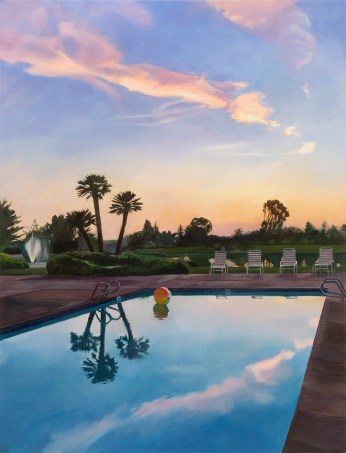
In 1982, she also started taking belly-dancing courses, because she had always been interested in the costumes. “I really wanted to wear those clothes,” she says with a Cheshire Cat look.
Eventually, she started performing, and for 10 years, she was the Tuesday night dancer at The Greek at the Harbor in Ventura, where she made $30 plus tips. “I figured I got a new costume every six months,” she says. “It was great fun. It was great to have an audience. I was always a shy person, always a lonely kid, an introvert who longs for a little extroversion. I can’t say I enjoy being alone painting, but it’s part of the job. I have a couple of friends who come over to the studio and paint with me.”
“Her masterful paintings convey a sense of both the familiar and the haunted,” says Walker. Chidlaw’s works, whether the images are of highways, pools or drive-ins, have a run-down aspect in them that adds intensity to the beauty adjacent to it. A painting of hers featuring Christmas lights on a mobile home has always captivated me. It’s like the contrast between light and dark. Some of her work reveals a fascination with neon lights. “I do like neon,” she admits. “Neon is a different light. It’s fun to paint.”
Chidlaw uncovers poetry in the everyday or the commonplace, and there’s always some enigma — a mystery in her work. The rare figure stands alone at a bus station — or seated at a diner unaccompanied. “Why?” you’re left to ponder. “Stories are more interesting when they’re less explicit,” she reveals.





You must be logged in to post a comment.